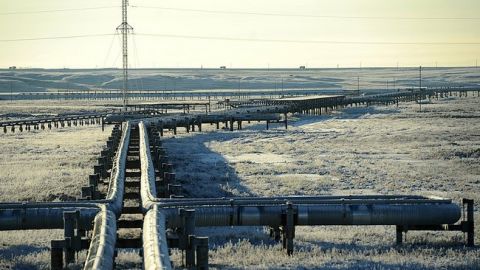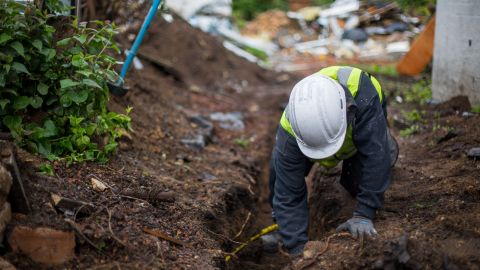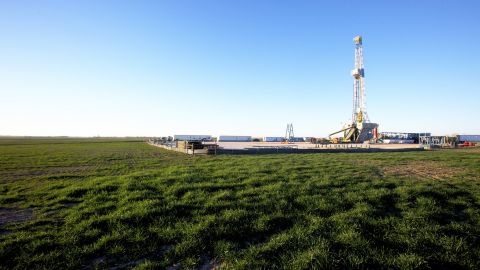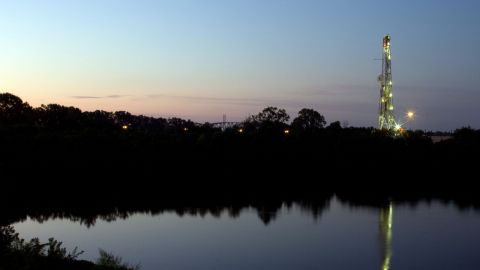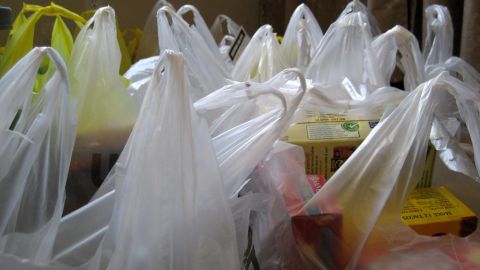AD READER: This episode of The Sweaty Penguin is brought to you by my super cool painting. Do you need something to throw soup at? Try my super cool painting today.
ETHAN: Welcome to episode 107 of The Sweaty Penguin: Antarctica’s Hottest Podcast. I’m your host, Ethan Brown. Today, we are talking about North Dakota, Montana, and Saskatchewan because, well… no one else is.
ETHAN: Specifically, we’ll be talking about the Bakken Formation, a layer of sedimentary rocks in that region that is home to [drumroll] another carbon bomb! Yeah, you probably could have guessed that one. carbon bombs won’t actually cause human extinction or anything, but they are pretty scary. In May of this year, The Guardian published an investigative report on carbon bombs that revealed that the world’s largest oil and gas companies have either started or planned 195 carbon bombs. 3These 195 carbon bombs combined would emit 646 billion tons of carbon dioxide. There is nothing on this planet that we need 646 billion tons of. Absolutely nothing… I mean other than nutella … but nothing, absolutely nothing.
ETHAN: As the founder, host, and benevolent-ish dictator of The Sweaty Penguin, I’ve made the executive decision that we must cover every single one of these projects. That’s right. Nearly 200 episodes dedicated to carbon bombs. To put that into perspective, we just released our 100th episode a few weeks ago. So this could take years.
MEGAN: And if you’re listening to this, my name is Megan Crimmins, I wrote this episode and I need help, I don’t know if I can do another 190 of these and things are starting to get… [cut off aggressively]
ETHAN: Sorry about that, I don’t know what that was. Um where was I? Carbon bombs, right, our team loves carbon bomb episodes.
EHTAN: Today, we will take a look at the Bakken Formation. The Bakken formation spans 200,000 square miles in northwestern North Dakota, northeastern Montana, and southern Saskatchewan. And while the Bakken rose to fame with its high yields of crude oil in the last few decades, it wasn’t always like this. The Bakken actually used to be pretty chill and down to earth, but then people started moving across the country just to be near it, and the fame really got to its head. Now, it’s home to a carbon bomb project set to emit 5.9 billion tons of carbon dioxide, making it the sixth highest emitting oil and gas project in the United States. Today, we’ll discuss what issues stand out in the Bakken Formation, how the area is evolving due to economic growth and climate change, and what comes next for this major oil producing region.
ETHAN: The Sweaty Penguin is presented by Peril and Promise: a public media initiative from The WNET Group in New York, reporting on the issues and solutions around climate change. You can learn more at pbs.org/perilandpromise. If you want to take two minutes to help out The Sweaty Penguin, you can either leave us a five star rating and review or join our Patreon at patreon.com/thesweatypenguin. Doing that either earns you a special shoutout at the end of the show; joining the Patreon gets you merch, bonus content, and a whole lot more.
ETHAN: Now, before we get down to discussing fun new words like “Boomtowns” and “man camps,” we need to cover some background. Did you all catch that? That’s what we like to call a hook, because now you’re going to sit through me explaining the geological history of North Dakota just to learn what man camps are. The whole Bakken system consists of a sequence of black shale, siltstone, and sandstone that underlies large areas of North Dakota, Montana, and Saskatchewan. It is just 1 of 15 primary producing formations in the Williston Basin and can vary from a few thousand feet underground to around 11,000 feet in deeper areas in North Dakota. It’s like a pool at a water park — either it’s a few feet deep or ELEVEN THOUSAND FEET DEEP AND YOU’RE GONNA DROWN AND HALF OF IT’S URINE AND THERE’S A LOOSE BANDAID FLOATING AROUND OH MY GOD GET ME OUT OF HERE. This varying depth is the result of the geological processes that formed the Bakken hundreds of millions of years ago. According to North Dakota geologist Kathleen Neset, that geology has meant we still don’t quite know where the Bakken Formation’s oil is.
CLIP As we move across the state of North Dakota, from the East to the West, the rock layers are actually down in a depression. This depression was originally created hundreds of millions of years ago. The crust of the earth was shifting and it allowed for this depression to occur, and on top of the basement granite rock, over the hundreds of millions of years, sedimentary layers have filled in the depression and we are now drilling through these zones identifying which ones have oil in them.
ETHAN: First of all, to the depression starting hundreds of millions of years ago… same. At least that’s what it feels like. But as much as I want to turn The Sweaty Penguin into a therapy session, I really want to focus on that last thing she said, that we are now drilling through these zones identifying which ones have oil in them. We actually knew about oil and natural gas reserves in the Bakken as early as the 1950s but we didn’t start drilling much until the most recent decade or two and that’s because in the early 2000s, the Bakken was considered a pretty mediocre resource. It was like the foam pit at gymnastics. You love the squishy foam things no matter how much of a health hazard they may be, but you’re also not going to, like, take them home with you. Ew. It was only until recently that it even became conceivable to drill oil from this region, and due to the unique sedimentary rock layering that Kathleen explains, we’re still figuring out where the oil actually is.
So what changed in the early 2000s? Well, it starts with an F, ends with “I-N-G”… Anyone?? NO not THAT F word, get your minds out of the gutter, and into the geological depression. I’m talking about fracking. Besides being RuPaul’s favorite pastime, fracking is a relatively recent technique used by oil and gas companies where they drill not just down into a deposit, but once they reach a certain depth, the pipe they’re using turns into a transformer and actually goes horizontal for some length before extremely high pressure water is shot through it and that water cracks the rock surrounding it, breaking the oil and gas trapped in those rocks out of their shale prisons. That is more or less what fracking is, but if you want more details, literally pick any of our other episodes at random and your chances of finding an explanation of fracking is about 50/50.
With recent innovations and improvements in fracking and horizontal drilling, states like North Dakota have gone from just a place where you can see some shiny green lights in the sky to the second highest oil producer in the United States behind Texas. Over 11,000 wells have been drilled across the Bakken since 2013 with about 1 million barrels of oil coming out of the region every day, as compared to only 2,884 barrels per day in 2005, and this production is only going to grow with newer innovations in technology.
What does this influx of oil production mean for the environment? Obviously for the world, that oil is going to get burned which will release carbon dioxide and warm the planet, except for that one barrel that escaped the truck, ran into the woods, and became friends with a family of pelicans. But there’s local issues too. For one, there’s been a massive influx of transportation to carry all the equipment it takes to dig wells, and to carry out all the crude oil that must go to refineries, creating pollution through increased levels of traffic and the use of large trucks and trains. Because wells are often dug out in less developed land, many dirt roads are created for this type of transportation, kicking up a lot of dust, which can lead to health issues for local residents. And the practice of fracking specifically leads all those layers of rocks to break, which can lead contaminants deep in the earth to pollute surface-level water. In fact, one resident referred to a stream on her property as “rainbow, slimy stuff” and said the water was literally bubbling. Seriously, what is this, My Little Pony? I mean, I don’t know why they’re complaining, that sounds like something you could sell tickets to!
There’s also a major issue related to natural gas in the region. For this episode, we interviewed Dr. Wesley Blundell, Assistant Professor of Economic Sciences at Washington State University. Even though there is natural gas in the Bakken, Dr. Blundell says companies in the region are much more focused on oil.
- BLUNDELL: Primarily in North Dakota they’re drilling for the oil. That’s where most of the money is. And you can imagine a significant amount of a logic behind the drilling or in these processes is As we get some natural gas sold, that’s just creamon top. But again, the real money is the oil wells and then the problem in particular with North Dakota during our sample time, period, 2007 to 2015 is North Dakota really hadn’t, seen a giant oil boom prior to that point. So there really wasn’t infrastructure in place to take all this natural gas and process it.
ETHAN: So what do they do with the natural gas? They set it on fire. [flame sound] No, literally. This is a process called flaring. When companies are just trying to capture oil but end up releasing natural gas in the process, they set the natural gas on fire, which ultimately wastes the energy and releases carbon dioxide into the atmosphere. And, I mean, come on. We can’t just take everything we want to dispose of and set it on fire. My white T-shirt with a hole in it from eighth grade specifically requested a burial.
ETHAN: To North Dakota’s credit, flaring has become somewhat less of an issue there, with 2021 data showing that North Dakota only flared 7.5 percent of produced natural gas as compared to an average of 19 percent in 2019. But flaring has still racked up quite a few issues in the area. For example, the flares are extremely bright. They’re like iPhone flashlight when you need to use the bathroom at 3am bright! And in an otherwise pretty rural region of the country, that creates a major light pollution problem. We have a whole episode on light pollution where you can learn some of the human health and environmental consequences of that, but it’s especially of note here because North Dakota and Montana are two of the only states in the United States where you can see the Northern Lights. And sure, you could just turn on Brother Bear and see them there, but that’s not the point. The Bakken region is also home to Theodore Roosevelt National Park, and light pollution, as well as all the other aforementioned pollution, certainly does not help that important ecosystem.
ETHAN: Flaring also has some major consequences for human health. Dr. Blundell recently published a study in the Journal of Public Economics on the human health costs of flaring in the Bakken Formation. Have a listen.
- BLUNDELL: I started this study back in 2015, when we were graduate students at the University of Arizona, The state of North Dakota was flaring, her burning off for no use about a billion dollars a year at this natural gas. We’re like well we know that it’s not processed and clean like the natural gas at electric generation facility so there’s going to be a lot of pollution that’s coming from this. So we did some you know just very simple [00:02:50] crude calculations were thinking. Yeah there’s got to be some significant pollution that’s going on from this app activity. And so then we went about and we tried to get hospitalization data and we found a pretty good data set that covers. I would say more than 90% of patient hospital visits in North Dakota for roughly a nine-year period. and so, then, They’re like, okay but how do we Define exposure because it’s everywhere, you know, the urn Western North Dakota, there’s flaring. These this natural gas would contaminants being burned. And then you know, creating this pollution to the north of you to the west of you to [00:03:35] the east of you to the south of you. So how do you define exposure to flare natural gas? And in addition to that, there’s a whole bunch of other stuff that’s going on because these are oil wells. So, Trucks going in to transport the oil out. If there’s no pipelines, there’s drilling that’s going on and, you know, there’s building of, you know, the infrastructure for the people who are working in these fields to live. So how do you separate out those pollutants? And so [00:04:05] we got wind data, we use the fine, Geographic data of individual, well, sites, their monthly reported flaring, and we sort of created a measure. We drew a circle around Each zip code and we’re like, okay, within this given month, given the wind pattern within that month, how much flare natural gas were they exposed to. […] We got the final number which is flaring in North Dakota over a nine-year stretch was responsible for 11,000 additional respiratory related hospital visits and we thought well that seems pretty big and then we did the dollar cost and we’re like oh that’s that’s this is racking up. You at least 50 million a year possibly up to 100 million dollars a year in health costs again for an activity where they’re just burning a resource that many consider valuable for no industrial use.
ETHAN: 11,000 additional respiratory related hospital visits. And again, this is a pretty rural region, making that number feel even bigger. But what’s worse? Dr. Blundell’s research found that these flaring impacts have not been felt equally.
- BLUNDELL: Let’s just take what is the percent of all the oil royalties extracted within a particular zip code versus what is the percent of total exposure to flare natural gas? That zip code gets and indeed, the wind is not fair, we found that 50% of exposure to flared natural gas is experienced by ZIP codes that extracted, less than twenty percent of all the oil wealth. During our sample time period. Now not only that I guess the wind is particularly cruel. If you want to think of it this way, the communities that are communities of color, or those that have lower levels of income or communities with lower levels of employment, a lower employment rate, Are disproportionally exposed to the pollution from their natural gas. […] I would say the environmental justice, takeaway here is that although we have a dollar figure for the health costs, we have a dollar figure for the climate costs but clearly there is another factor that needs to be considered for these polluting activities which is that the harm is just disproportionately going to those communities that might already be historically disadvantaged or just currently disadvantage lower levels of employment lower incomes.
ETHAN: Come on, wind! Seriously, if wind doesn’t post a notes app apology to Twitter in the next five seconds, it’s going to be canceled. The idea that natural winds were spreading pollutants to already disadvantaged communities, though, is really eye-opening to me, and I’m so glad Dr. Blundell could share that research with us.
ETHAN: So if people in the Bakken are weathering all these health and environmental issues, this oil production must be sensational for the local economy, right? Well, yes and no. The industry, to its credit, provides jobs for thousands of people, and oil companies pay millions of dollars to the state in taxes and workers’ wages. Local businesses can also bring in more money from an increased customer-base. This has been so impactful that North Dakota has the second highest employment rate in the U.S.
ETHAN: But it’s not all good news. For one, the aforementioned health and environmental impacts come with a monetary cost. Through his research, Dr. Blundell was actually able to put an exact number on it. Have a listen.
- BLUNDELL: You know, we create these additional amount of CO2 and that’s going to keep the Earth and that’s going to impose some economic costs going to harm economic growth in certain ways you can imagine you know there’s additional extreme weather events that cause damage all sorts of things. And so it boils down to is there’s this debate on how much per ton of Damages that CO2 has and 25 or 40 dollars or some say, you know, $250 of time and so in the case of natural gas, you can back that out. You know, if the gas has flared perfectly which is not the right assumption. There’s research that says ] it’s not being cleared perfectly, but if it is then per thousand cubic Big feet of natural gas being flared in poses, two dollars and seventy cents of climate costs. That is they corresponds with an additional heating of the earth that will cause two dollars and seventy cents today worth of the equivalent today worth of economic damage. And so that’s where we got the climate cost, two dollars and seventy cents. Number comes from another paper but we took the amount of flare natural gas that we knew in North Dakota So we have and we know it’s two dollars and seventy cents per thousand cubic feet. Then we compare it to what we know this 11,000 additional respiratory related hospitalizations and there’s a number of papers in the literature that sort of get at what is the cost. Because you know, not every typically when someone goes to the hospital, then they don’t cover the full cost of their hospital visit. So what is the real total economic cost of each of these hospital visits? And I think the number was around 27,000 dollars, that’s actually comparable to with. We actually have the we have the reported cost for each of these visits in the data. So if we just take the average reported cost whore, her respiratory related hospital, visiting our data 27,000 dollars. And you know works out to we get about a dollar and forty three cents per thousand cubic feet of Health costs.
ETHAN: To add a bit of local context to that climate cost, North Dakota is actually almost 2.5°F warmer than it was 100 years ago. If it gets any warmer, they’re going to have to rename it South Dakota! Wait… we already have one of those. Is Tropical Dakota taken? This warming has led to a higher intensity in periodic droughts, an increased number of heat waves, higher levels of flood risk, and more intense and frequent wildfires. In fact, Fargo, North Dakota is the 10th fastest-warming city in the United States, right behind Oven, New Jersey. Okay I made that one up, but the point stands.
ETHAN: Montana’s feeling the heat too. Montana’s hot days are becoming extremely hot while cold days are becoming extremely cold, and wildfires have increased in frequency and intensity. And if we go to Montana’s Glacier National Park, they used to have 160 glaciers in the late 1800s, but now, only 25 glaciers remain, and scientists predict that they could completely disappear in the next two decades. And, I mean, Glacier National Park with no glaciers? What are they gonna call it then, Preventable Tragedy National Park? That just doesn’t have as nice a ring to it. All this is to say that The Bakken region and its surrounding towns are absolutely feeling the costs of climate change, and while oil from the Bakken certainly isn’t the sole cause of climate change, I think it’s fair to draw a loose link, especially with North Dakota being the number two oil producing state in the country.
ETHAN: In addition to those costs, the Bakken is home to many “boomtowns.” Boomtowns refer to towns near an oil boom, not to be confused with “boomertowns” which are towns in Central Florida or “boomboomtowns” which are [very long bleep, like you’re bleeping out an entire sentence]. Oh, right, I forgot we’re PG-13. These boomtowns have seen a massive lifestyle shift as oil projects have rapidly moved in. Prices skyrocket, making it hard for locals not working in the oil industry to find affordable housing or pay for groceries. New houses are built quickly and inexpensively, so they can be falling apart when people move in. And property owners end up pushed off their land due to soaring costs of living and the high profit they can make off selling their land to oil and gas companies. All of these factors have been really difficult on the pocketbooks of local residents in boomtowns. Even if lots of money is coming into the region, they’re not the ones seeing the benefit.
ETHAN: Boomtowns also have experienced a major safety issue. Many of the people who move to town for these jobs are single, young men. So THAT’s where they all are. The smell of Old Spice must be absolutely overwhelming. But don’t get too excited — these bachelors end up living in what are called “man camps,” essentially just sprawling, temporary housing dedicated to these workers. But man camp is a lot different from that sleepaway rugby camp your dad told you would be fun one summer. Man camps often attract drug and human trafficking, and the lack of connection to the local community can lead to safety issues for locals too. Night life changes, bars become more crowded, fights break out. In fact, one study showed that violent crime in Boom counties rose 18.5% between 2006 and 2012. And arrests in Sydney, Montana have increased by 165% in three years, with many of these being drug and robbery related.
ETHAN: Boomtowns also often see a rise in sexual violence, sex trafficking, and daily harrassment from male workers. Women in numerous videos that we watched while preparing this script discussed how they leave their homes less often and don’t feel safe when they do, they carry weapons or pepper spray, or they don’t go out at night at all. In Sidney, Montana, for example, a high school teacher was killed on a morning run, and two men who had come to town for the oil boom were charged with her murder, a tragedy that shook the community. And this danger for women is especially bad for Indigenous communities. Missing indigenous women tend to get less press coverage and investigative support from law enforcement.
ETHAN: So is all hope lost in the Bakken? Should North Dakota and Montana be banned? Of course not. In our next segment, we’ll explore how the region moves forward in a way that maintains economic prosperity but also prevents its water from becoming a tribute to My Little Pony.
AD READER: Are you a climate activist? Then my super cool painting is for you. I spent the last five years working on this painting, and while I can’t get it into the news myself, if you throw soup at it, you could make it famous! And while I don’t want to damage my super cool painting, I’ll risk it because if you get everyone riled up, that means everyone has to admit they like my super cool painting, and that would look really good for me as the artist. Sounds like a deal to me! My super cool painting: just don’t use clam chowder, I don’t want it to smell bad after.
ETHAN: So where do we go from here? Well, South Dakota, probably. Screw up one, go to the other, right? In all seriousness, on the oil side, Dr. Blundell says being mindful of where you drill is a start.
- BLUNDELL: What would help for I think for the future of the region, I hope for a more judicious process in terms of where drilling is permitted, if that makes sense. So I think the biggest waste is when you have these Wells drilled where there’s absolutely no chance that they will ever be able to have their natural gas processed or used for industrial use when there were other alternative sites nearby that would have been. Environmentally damaging. I think we’re, we can see gas prices right now and it’s a huge issue in the news. We’re not at the point yet where people will reasonably expect drilling to stop in the next few years. But certainly, I would hope that if additional drilling continues, that the choice of Where to drill is made with more consideration of these climate and health costs from flaring. And so, the drilling would shift to areas where those costs are are diminished.
ETHAN: Some areas might be more polluted than others, more ecologically significant than others, or more populated than others — as in, seven people instead of six. And as his study found, the wind is not fair. It’s like parents, or roughing the passer penalties that cost me my fantasy football game. Seriously, AJ Brown, you’re undefeated playing the Washington Commanders, catch a pass! It might not be the easiest thing to do, but being mindful of drilling locations and making careful choices certainly makes a lot of sense.
ETHAN: Another approach is to continue to work at reducing flaring. That’s right. The Bakken doesn’t need flare… it needs zazz. [some sort of broadway-ish sting] Obviously reducing flaring doesn’t fix the fact that oil from the Bakken is leading to carbon emissions, but it would be a massive win for people living in the Bakken region facing localized environmental and health impacts. And there’s a number of ways to do that policy-wise, but according to Dr. Blundell, having that dollar value assigned to flaring which his research did makes policymaking a whole lot easier.
- BLUNDELL: There are costs. I mean the dollar costs are significant when you’re having this because there are policies. Now, to restrict flaring came in during the end of our sample time period, there’s been discussions in other states for ways to reduce flaring and Oftentimes as an economist I know you need a dollar value to each side of the argument and this is clearly a tangible figure, we have a dollar and forty three cents per thousand cubic feet, if you have a population density of 6.2% where Mile and increases with population density. So now, when you’re talking about policies works, we should tax layering, or we should find Wells for have unnecessary flaring. You know, what? Ever the potential policy might be, you know, you can imagine a cap-and-trade system potentially where, you know, firms are given. Well, we know that if we don’t do that, what the dollar costs equivalent are not just in terms of health, but also, There’s that research about what is the climate cost per thousand, cubic feet of natural gas flared? And so, ultimately, I think once you have those numbers, people can be more formed informed about what is the most economically efficient policies? You just care about efficiency. Well, now you have some of the numbers to try and get to that point.
ETHAN: And that’s awesome. But here’s the issue. If you continue to drill oil and you don’t flare the natural gas, what’s the alternative? Snorting the gas? Putting it in a Diet Coke bottle for a TikTok challenge? There’s two main options, and neither are great. One is venting it, or just releasing it directly into the environment. Obviously, therapist approved. [like a right answer or stamp of approval sound?] But natural gas, you may remember, is largely methane — a greenhouse gas with 28 times the global warming impact of carbon dioxide. When you burn the natural gas by flaring it, you turn it from methane to CO2, and while that’s not ideal, it’s a whole lot better for the climate than actually releasing pure methane. However, venting would reduce some of the light and noise pollution that comes with flaring, so I guess that’s something.
ETHAN: The other option is collecting the gas and selling it so people can use it as energy. You could even trade it like baseball cards! The pro here is that at least you’re not wasting energy, and you can bring some money into the region. But it also costs money to collect and process this natural gas, and again, it doesn’t eliminate the environmental impact. It might eliminate some local environmental issues for people in the Bakken region, but some community further down on the supply chain will then have to bear them. So there’s a lot to weigh in making that decision.
ETHAN: But here’s where the Bakken Formation specifically presents a challenge. In some carbon bomb sites we’ve covered in the past, they already have natural gas infrastructure set up. In the Bakken — a young carbon bomb known primarily for oil and hotdish — they do not.
- BLUNDELL: So, you know, compared to say Texas, which is experienced many oil booms, prior they have what are called Gathering lines, natural, gas processing plants in place and then of course, transmission lines, that will help bring the process natural, gas, stripped [00:10:41] of all those contaminants that create the pollutants that cause the respiratory hospital visits in our paper. But in North Dakota, you don’t have those Gathering lines. You don’t have as many of those natural gas plants, you don’t have those transmission lines. And the reason why there isn’t an equivalent issue with oil is because at least oil in North Dakota has the alternative of it can be transported via truck. It’s not really realistic to take the natural gas and also transported via truck as well. And so that’s why More so than oil, you need that kind of infrastructure. If you’re going to bring natural gas from Individual, well sites to the final consumer.
ETHAN: So what do you do if you can’t put your natural gas on trucks? I mean, what would Bob the Builder say? Well, you have to build pipelines. And that’s not a proposition to take lightly because pipelines are even more controversial than Kris Jenner’s Vogue outfit. Just looking at oil, the Bakken has already been at the center of famous pipeline disputes such as the Dakota Access Pipeline and Keystone Pipeline. Listen to this clip from six years ago of Native Americans protesting the Dakota Access Pipeline.
CLIP We’re here to pray. We’re just here to pray. –This land is where the Dakota Access Pipeline is being built. –It’s scary because to shoot rubber bullets at these people that are completely unarmed when they took an oath to protect them. –Police used pepper spray and rubber bullets to disperse them. –You got hit? Josh! He just got you? –Get a medic! –Get a medic! […] They beat up a lot of relatives and we had grandmothers there. They shoved our grandmothers around. They dragged our grandmothers around.
ETHAN: The reason we’re even talking about a solution to flaring is to help locally. Collecting and selling gas doesn’t fix the climate. What collecting and selling natural gas is supposed to do is bring money into the community and reduce those local environmental and health issues. But clearly, as we can see from this clip when the Dakota Access Pipeline was being constructed, pipelines are not helping locals. It passed through Indigenous land, caused damage to that land I might add, and when the community peacefully expressed their outrage by praying at the edge of a creek, police shot rubber bullets, used pepper spray, and shoved grandmothers. That’s horrifying. And if we had more time, I’d talk a lot more about pipelines today — obviously many like this one are already there — but I think it’s clear from this clip that even though flaring has this local dimension, pipelines are not a local fix.
And on top of that, according to Dr. Blundell, pipelines might make things worse on the climate side too.
- BLUNDELL: You would think. Well, there’s this. Here’s a clear argument for the pipeline’s, but it’s not so clear, because if it’s being put onto lines, it could leak out as methane, which is 85 times greater heating potential than CO2. And it also, if you’re thinking long-term would make it harder to switch away from fossil fuels, natural, gas, Etc. Later, if we continue investing in these large-scale infrastructure.
ETHAN: So yeah, there’s a lot of factors to consider here and I don’t have an answer, but these are great conversations to have within the community to figure out what path forward works best for them.
ETHAN: But there’s another path too that eliminates all of this, and there’s one Bob Dylan lyric that sums it up: “How many seas must a white dove sail before she sleeps in the sand?” No, that’s not the lyric, although I’m pretty sure the answer is seven. Why Bob cares about white dove sleep schedules though is… well, it’s a little sus. Sorry, I’m getting sidetracked. No, the answer is blowin’ in the wind! North Dakota and Montana are both extremely viable locations for wind power, with wind blowing unobstructed through the states at a pretty constant rate. In 2021, one-third of North Dakota’s net energy came from wind power, meaning that the knowledge and infrastructure to expand wind energy is already there. And Montana might rank 24th in the nation for installed wind energy production, but it’s ranked 5th for estimated potential in onshore wind power, meaning it has significant untapped potential. Working to transition these states towards renewable energy would allow for the region to continue providing jobs for people in the energy industry, while working towards a cleaner atmosphere. Now that I think about it, maybe I shouldn’t have canceled wind in the first segment.
ETHAN: Of course, there’s a lot more angles to this as well. The boomtowns and man camps present major issues that I’m probably not qualified to solve. My best idea is making billboards that say “don’t turn boomtown into doomtown” and watch people’s attitudes change immediately. And it’s worth adding if oil were phased down but the wind industry brought a similar economic boom to the region, these issues may not go away on their own. It may take a concerted effort. But seeing the potential for new industries, ideas for reducing impacts, and most importantly, the engagement from the communities on this issue, I absolutely think there’s a path forward here. It won’t be easy, but with the right plan in place, the Bakken Formation could see a strong economy that doesn’t leave people behind, a cleaner environment, better health and justice, and ensure the region never has it as bad as Oven, New Jersey.
ETHAN: And that wraps up episode 107 of The Sweaty Penguin. Take two minutes, help out the show, and get a shoutout at the end of the show by leaving a five star rating and a review on Apple or Podcast Addict OR join our Patreon at patreon.com/thesweatypenguin. You get merch, bonus content, and more.
ETHAN: Clips today came from North Dakota Petroleum Foundation and NBC News. Special thanks to our Emperor Penguin patrons Lawrence Harris and Brownies Central. The Sweaty Penguin is presented by Peril and Promise: a public media initiative from The WNET Group in New York, reporting on the issues and solutions around climate change. You can learn more at pbs.org/perilandpromise. The opinions expressed in this podcast are those of the host and guests. They do not necessarily reflect the opinions or views of Peril and Promise or The WNET Group. Thank you all for listening, and I’ll see you next week.

